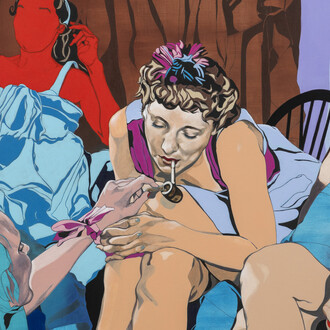Althuis Hofland is proud to present the exhibition Gentle delay by Karel Dicker (1989, NL), the artist’s first solo exhibition at the gallery.
Over the past months, Dicker has traveled extensively, carrying his studio with him across Europe. While his studio in the south of the Netherlands — a self-built, light-filled space in his garden — remains a place where memories unfold into fictional space, the act of traveling opens a path to new inner dialogues.
Encounters with unfamiliar surroundings compel Dicker to look, to collect impressions, and later to reconfigure them on canvas. His works rarely depict the actual places he has seen; instead, they emerge as recollections of them. Rooflines in Rome, sandstone in Arles, the fleeting light of a morning walk — observations transformed by memory into images that hover between reality and imagination. They are metamorphoses of bodily experiences, turned into fiction and treated by Dicker as sculpted matter. Each is enhanced by hand made thick, idiosyncratic artist-frames, and the depicted that is constructed through layers of color, form, and gesture — built up and erased in equal measure.
This process recalls Pierre Bonnard’s belief that painting happens not before the motif, but in the space of memory. Like Bonnard, Dicker paints not what he sees, but what remains after seeing. For Dicker, traveling is always a dual gesture: at once observing and translating, letting go and holding on. In temporary studios — with fewer belongings, shifting light, and unfamiliar interiors — his paintings acquire a different rhythm: slower, yet more distilled. The unforeseen plays a crucial role: a meal never tasted before, a spontaneous meeting in a café, a sudden morning light. These unplanned moments resist cliché and open his work to a fluid, imaginative play.
Travel, in Dicker’s words, is both mirror and shelter. Each journey reflects where he stands within himself, blurring the line between moving through the world and moving through one’s own inner landscape. This tension is vividly present in his recent works — paintings that carry fragments of Pompeii, Rome, and other cities, stitched together in layered compositions. They embody the artist’s central question: how to create rhythm while remaining open to the unknown?
In his canvases, control and surrender exist side by side. What begins as an attempt to capture the whole often dissolves into an intimate dialogue with detail. Dicker’s works remind us that the act of painting, like the act of traveling, is never fully predictable — it takes shape in the space between planning and coincidence, presence and memory.













